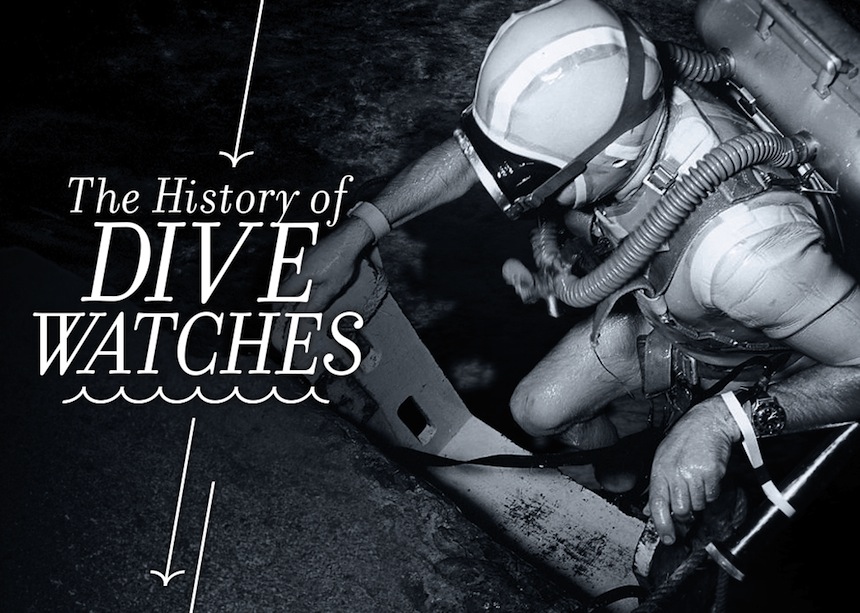
There are many things we take for granted when speaking about modern timepieces, and one of those is water resistance. There are no “water proof” watches, as that implies water would not be able to enter them under any circumstances, so we use the term “water resistant.” The history of water resistant watches really began in the 1920s, but it was not until later that the serious water resistant diving watch came into existence. Today dive watches are the most popular type of sport watch, not necessarily because people use them to dive, but because of their style, promise of durability, and utilitarian value.
Regardless of whether one pays a few hundred or several thousand dollars for a watch, they rightfully expect reliability, accuracy, and comfort. Having said that, we are rarely reminded of just how much time it took wristwatches to transform from fragile pieces of art into workhorse instruments that can put up with most of the challenges we expose them to during our daily lives. Today we are looking into the history of water resistant and diving watches. We will discuss the most important historical models, their respective design elements, as well as the challenges they have faced and conquered.
Much like in the case of our article on the History of ETA, the Swiss movement maker, we have to begin with a disclaimer, noting in advance that there is no one source that would list all relevant information. Instead, there is a great number of different–and superb–sources that detail different aspects at length, often revealing contradictory information. With that said, let’s dive head-first into the more than a century deep history of waterproof watches.
The history of the wristwatch deserves a dedicated article which it will receive another time, but for now we will say that it was not off to an easy start. The first men’s watches worn on the wrist were created from pocket watches that had lugs soldered onto their cases. Soldiers of the late 1800s and then of World War I sought a faster, easier, dare we say, “hands-free” way of telling the time while in combat. In general, however, wristwatches were considered to be womanly jewels that needed to be handled with excessive care. Consequently, men did not really care for early examples of these timepieces. The issue was their notoriously poor reliability: they were prone to breaking as they were exposed to a significantly greater amount of shocks, humidity and temperature changes when worn on the wrist and not inside the pockets of coats and vests.

It had been clear that wristwatches would never gain popularity unless these issues were gone for good. Among the primary sources for all these problems were water, humidity and dust, all easily finding their way into the movement through the gaps around the crown and in between the inaccurately machined and assembled case elements. They would make components rust, cause lubricants to not function as they should and ultimately force gears and pinions to lock up and springs to deteriorate. So, first of all, if watches were to be worn on the wrist–giving them much greater exposure to these elements–there were some considerable makeovers to be performed as far as the manufacturing and assembling processes were concerned.
In harmony with what we have seen so many times while discussing the history of watches, it was the ingenious ideas of some engineers as well as the increasingly fierce competition in between key companies that led to the birth of some of the most important technological developments. Over the years, several great minds set to work to ultimately create revolutionary solutions which banished old ideas of the past. They engineered new designs that would serve to keep watches running throughout the following decades, or centuries even, designs on which we oftentimes rely even today.
The first step was to realize the source of the problems and then identify possible solutions so as to permanently rule them out. Pocket watches of the time–and note that we are talking about early 20th century here–and especially their cases were not crafted with high resistance and durability in mind. They were cherished and highly valued items and hence they spent incomparably less time exposed to nature’s elements than wristwatches did and do today. As we pointed out above, their cases bore little to no seals around the crown and universally they were made and assembled in a way that allowed fine dust and humidity get into the case and the movement.
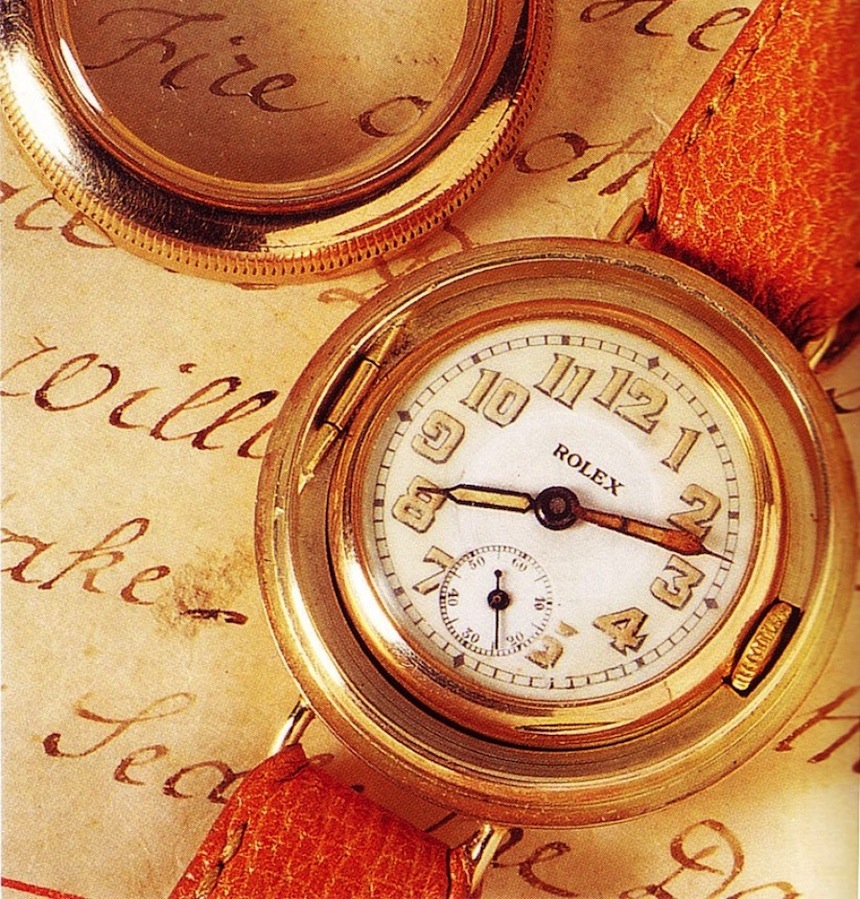
Some major watch brands appear to actually think highly of ceramic because a case substance and Blancpain nato watch strap Replica is among them. Formerly a closely guarded field of expertise of Rado and Chanel, ceramic technology and manufacturing techniques have only recently evolved to a point where more manufacturers are entertaining the concept of a ZrO2 instance, since a whole lot more control of things like colours and hardness is getting possible. The new-for-2016 Blancpain Fifty Fathoms Bathyscaphe Flyback Chronograph Ocean Commitment II watch case is all in blue ceramic – something the likes of which we haven’t seen before.Why we haven’t noticed it before? My perception is that achieving color uniformity and keeping adequate hardness at the exact same time has become the significant challenge of adding pigments into ceramic. That’s the reason why we mostly see black and white (and grey) ceramic (such as, say, this black porcelain Blancpain Fifty Fathoms Bathyscaphe). The challenge is that when the mixture doesn’t clean up completely and evenly following the heat treatment procedure, it will have discolorations and marks inside which will ruin the appearance — and the bit itself, since these imperfections cannot be removed.It is true that we’ve been seeing more and more colors in ceramic bezels from Rolex, TAG Heuer and a few others, and therefore it was perhaps only a matter of time before coloured ceramic instances came along. Plus it kind of also indicates a possible future of all types of colors for ceramic watch cases – Speedmaster Muave Side of the Moon, anyone? That might be kind of cool.
Shown here is the Rolex Hermetic (or Submarine) with its “lid” removed, revealing the crown and the inner case of the watch. Source: rolexblog.blogspot.com
Paving the way to the creation of the first waterproof wristwatch was one of the most important brands of today: Rolex, and most notably its founder, Hans Wilsdorf. Among the most obvious and easy-to-perform solutions were the use of additional, external cases, ones that would hermetically seal the “real” case of the watch. A great example of this is the Rolex Hermetic or Submarine from 1922 (not to be confused with the Submariner which is a completely different watch from three decades later). What the Hermetic offered was a small round-cased watch with a chunky external case around it, which had a “lid” that would screw down onto it. It worked like a jar where once you screw on the top, the jar is sealed for good. This made sense here as there were no properly developed crown sealing systems and the lid covered that as well. The problem this created was that every time the hand-wound movement was to be rewound or the time needed to be set, the lid had to be removed and then put on again. The frequent use meant that the grooves on the side of the brass lid and the threads on the inside of it wore out quickly, necessitating repairs.
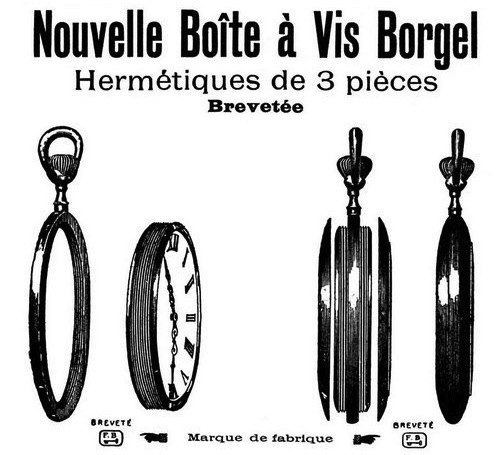
An old advertisement showing Borgel’s patented case construction, circa early 1900s. Image Source: VintageWatchstraps.com © David Boettcher
It was clear then that these oversized (because these chunky cases actually fit the term oversized) cases had no real future, at least not for the civil consumer. A more practical and more durable solution was needed and this meant there was no other way but to integrate all waterproofing into the watch’s case. François Borgel, a Genevan master case maker had filed two patents, in 1891 and 1903, respectively, for two slightly different watch cases that had threaded parts. A major upside of this design was that it omitted the external case. Instead it would enable the “normal” case to achieve same levels of isolation. Speaking about the more advanced 1903 patent, it comprised a threaded ring that would go around the movement and bezel, and the case back would be screwed onto the outer, threaded surface of this ring. This resulted in a superior seal, without having to use a chunky external cover.
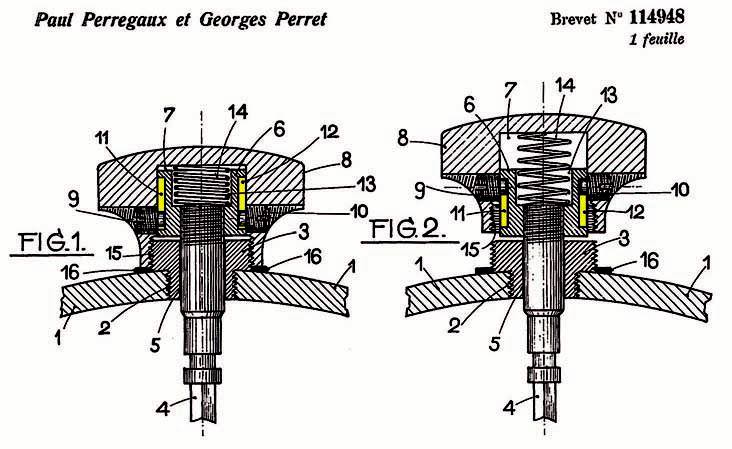
Seen here is the patent for the early screw-down design by Perregaux and Perret. The part marked 16 is the seal, located on the outside of the case. Image Source: VintageWatchstraps.com © David Boettcher
While this meant a huge leap forward and major manufactures like IWC and Longines have used Borgel’s cases for some of their watches, another major issue remained an unsolved mystery: the sealing of the crown. Humidity and fine dust could still find its way into the movement, albeit now at a slower rate, thanks to the threaded case design. The original idea–or at least the first patent–for a waterproof crown is credited to Paul Perregaux and Georges Perret. In October, 1925 they applied for a patent for a screw down crown, as seen on the extract from the patent above. As in the case of most breakthrough developments, the two watchmakers’ design also showed some imperfections.
To begin with, the unscrewing of the crown happened in the same direction as the winding of the mainspring. To secure it again, the crown was to be turned the other way around, against the winding ratchet. Once the watch was fully wound and the crown was set in its secured position, it could not be unscrewed again until the mainspring wound down to some extent. Furthermore, the black component marked with number 16 on the image above is the sealing which the crown (once screwed onto the case) would push against, to actually create the seal. However, this sealing–owing to the limited manufacturing abilities of the time–could not have been made of more durable materials, so it was leather, cork or felt. Since it was installed on the outside of the case, it would quickly lose its isolating properties, making frequent replacements necessary. Without getting much too nerdy, let’s briefly look at what–and who–made this already great idea perfect.
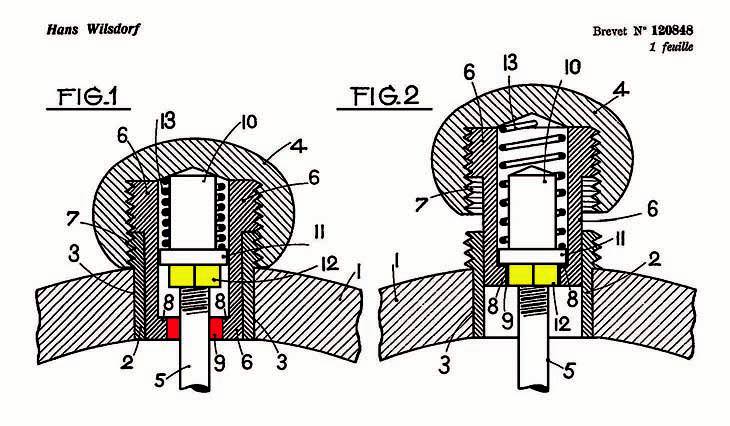
Rolex founder Hans Wilsdorf’s patent for the improved screw-down crown design. Image Source: VintageWatchstraps.com © David Boettcher
It was Hans Wilsdorf, founder and then-director of Rolex, who saw the potential in Perregaux’s and Perret’s invention as he realized that this idea coupled with the threaded case designs could ultimately create the first truly waterproof watch. He moved quickly and purchased the Swiss rights from the inventors and applied for the patent in the US, UK, and in Germany as well in 1926-1927. In the image above you see the results of a year’s additional development in the form of Wilsdorf’s own patent for the screw-down crown. Patented as CH 120848, one of the major improvements was the relocation of the seal from the outside of the case into the crown tube itself, while also making it from lead to enhance its durability.
Furthermore, the engineers of Rolex–and those working at C.R. Spillman SA, the case supplier of Rolex at the time–found a solution concerning the winding of the movement when the crown was being unscrewed: the crown initially rotates free from the stem and engages with it only when fully pulled out. This was achieved with what is marked with 9 (in red) and 12 (in yellow) on the image above. It is difficult to judge from the image, but these are two rectangular parts that engage once the crown is in the extracted position, hence enabling the wearer of the watch to set the time even if the mainspring is fully wound.
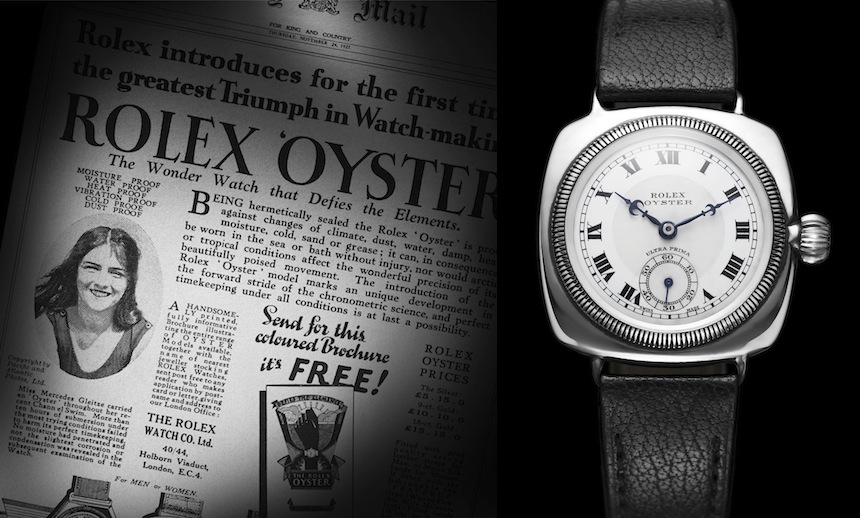
The Rolex Oyster next to the Daily Mail headline with long distance swimmer Mercedes Gleitze who wore the watch in an attempt to swim across the English channel
Rolex combined its improved crown design and the threaded case in a new model that became the first durable and reliable waterproof watch. Called the Oyster, it was a remarkable achievement, albeit one against which the general public remained skeptical. To learn more about this iconic piece check out Ariel’s article about the Oyster here. For now, we will concentrate on the process of how it turned into the legendary watch that it is and the way it managed to change people’s attitude towards waterproof watches. It was in 1927 that the perfect opportunity arose to publicly prove the abilities of his watch and Wilsdorf was again quick to react. It was then that the young British secretary and long distance swimmer Mercedes Gleitze set herself the challenge of swimming across the English channel–for the second time. Why the second? Well, the story goes that Mercedes actually swam across the channel once, only to be “topped” by another woman who claimed to have done the same feat considerably quicker, around 13 hours instead of Gleitze’s 15 hours.
At the time this attracted significant media attention and Wilsdorf wanted to have his share of it. Without going into much detail, we will just say that the other lady turned out to be a liar who admitted that she had not swam across the channel at all; a claim that made the media and the public question whether Mercedes’ previous achievement was a fabrication as well. At last, Wilsdorf agreed with Gleitze that she would wear the Oyster on a necklace throughout her “vindication-swim,” where she would prove the nay-sayers wrong . It is a lesser known fact that on this second attempt she actually did not make it all the way across the channel, but at this point it didn’t matter. A few days later the story of her and her watch were discussed on the first page of the Daily Mail, bringing the general public the first tangible proof of a waterproof watch. To make a more lasting impression Wilsdorf also arranged with retailers to have the Oyster showcased in their windows, set in a fish tank full of water. In conclusion, thanks to the exceptional developments and of course the witty marketing moves of the founder, Rolex–and with it the waterproof watch–made its first steps on the road that ultimately led it to prevail around the world.
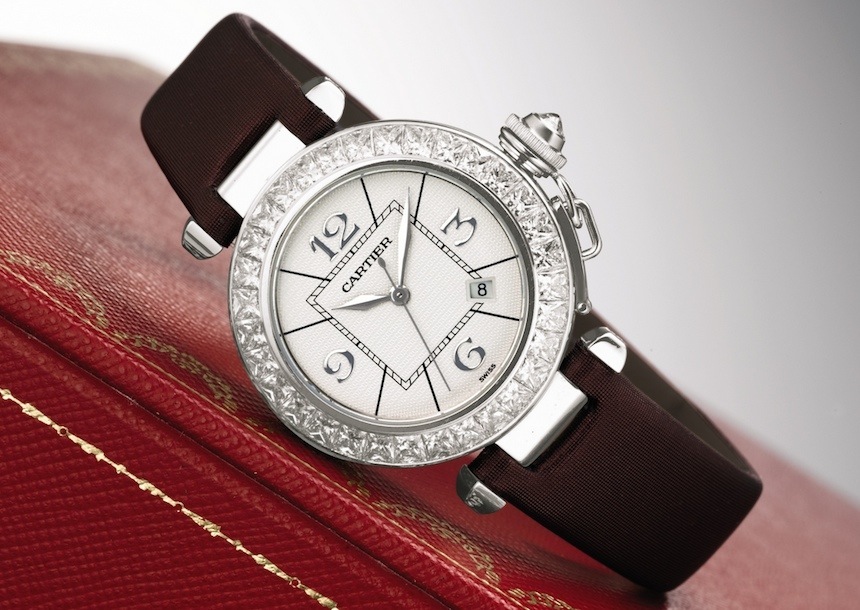
The Pasha de Cartier with its trademark crown cup and its tiny chain. Credit: Sotheby’s
Around the 1930s several other brands wanted to get their share from this new market segment. Turn your attention to two interesting interpretations of the waterproof watch, conceived by two already major brands: Omega and Cartier. Even at this time Cartier had been known as the go-to brand for the kings, monarchs and the world’s elite in general. This is exemplified by an order Cartier received in 1932, placed by the Pasha of Marrakech who, as the legend says, wanted a waterproof watch which he could wear during his occasional swims. Cartier answered the Pasha’s needs with a unique piece equipped with a round waterproof case as well as a little screw-on cap that served to seal the crown, hanging on a tiny chain fixed to the case itself. From 1943, and then from its 1985 “re-issue” up to this day, the watch is known as Pasha de Cartier, an iconic watch that is seldom recognized as one of the earliest examples among waterproof timepieces.
Around the mid-twenties, diving, an activity dedicated solely to scientific, military or “adventure-related” causes, started to become increasingly ubiquitous, brought about by the special breathing equipment developed by Yves Le Prieur in 1926 and then in 1933. The point of these diving related inventions was to make diving easier, less dangerous, while allowing them to happen for longer intervals, at greater depths. It is as complex of a challenge as it sounds, and then some. And while it took quite a few more years until diving could become more widespread, it had already been obvious that there was a need for wristwatches developed with the unique needs of this dangerous activity in mind. This is where Omega comes into the picture.
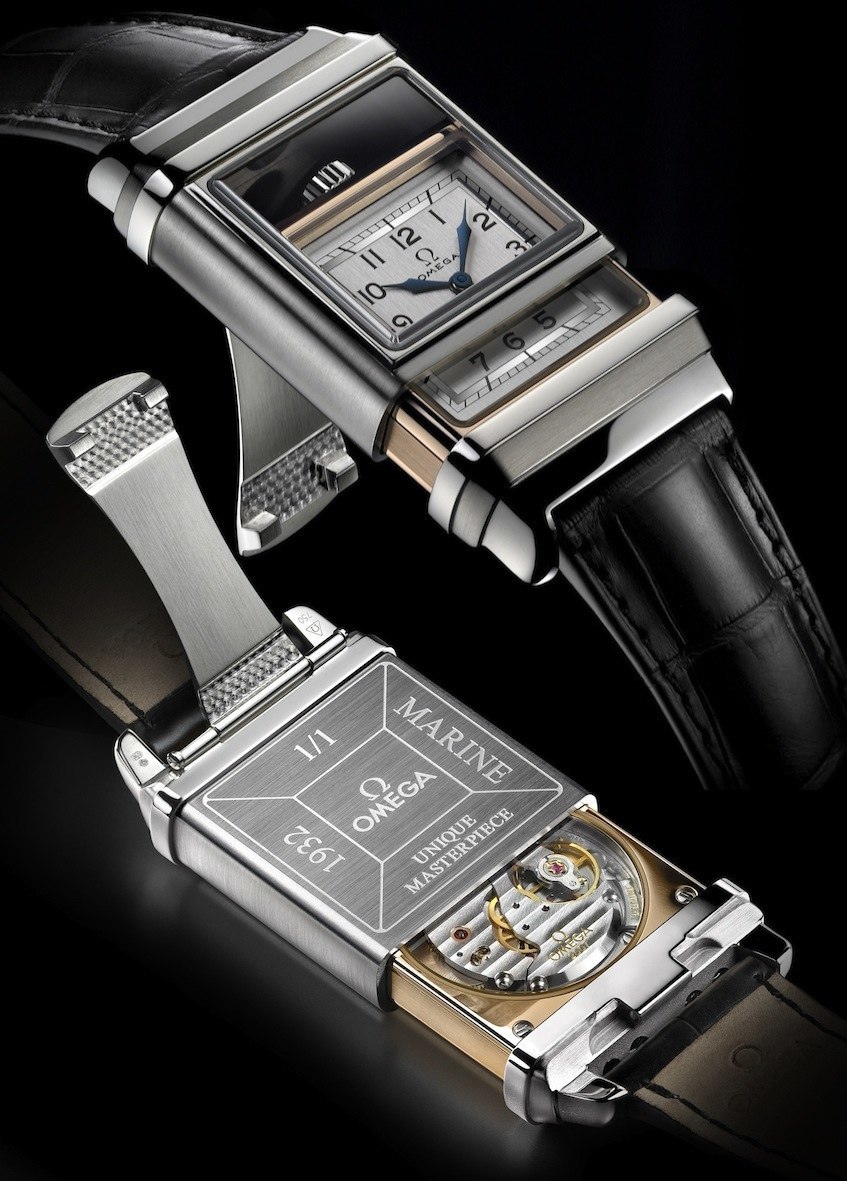
See, while the original Rolex Oyster and the Pasha de Cartier (and other lesser-known, albeit similar waterproof watches of the time) performed rather well when it came to keeping moisture, sand and relatively small amounts of water out of the case, they were not at all worthy of consideration when it came to the much more demanding, deeper dives. The first watch which was designed to tackle greater challenges, and hence to work with divers, was Omega’s Marine from 1932. This model brought the external, hermetically sealed case to the forefront again, something with Rolex’s innovations in mind may seem to be an outdated choice. Still, it actually was the fact that Rolex had those patents to its name that Omega had no other choice but to go with the external case, not to mention the fact that where they were going only a strong external shell could be used. With all that said, Omega’s final product turned out to be rather modern anyhow, as the Marine proved to be true to its name and became the world’s first diving watch, i.e. the first watch to successfully complete some seriously deep dives.
What made the Marine so unique and so capable was this two-part case, which had its top and bottom pieces connected to the straps, while a large clasp locked them securely on the case back. Furthermore, the Marine was the first watch to have a synthetic sapphire front, clearly an important step forwards in terms of reliability compared to any other material used at the time. The “package” was completed by a seal leather strap which, by Omega’s claims, were extremely resistant to salt water. The concept was ready so it was time to put it to its paces: Omega, likely “inspired” by Rolex’s marketing successes, set out to prove the special capabilities of their watch by testing through a series of challenges, challenges which were of previously unimaginable difficulty. In 1936 a couple of Marine watches spent minutes in hot water (of 85 degree Celsius) and were then quickly submerged to a depth of 70 meters in the 5 degree Celsius cold waters of Lake Geneva for thirty minutes. When they were taken out, all pieces (two complete watches and a case with no movement inside) were functioning perfectly, showing no traces of water inside.
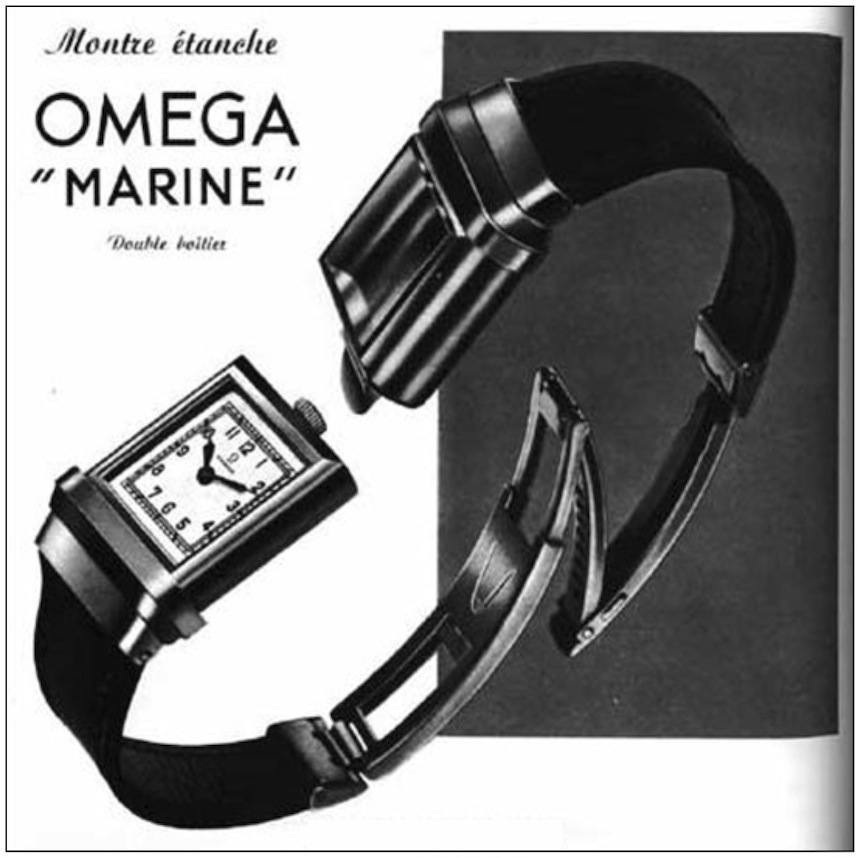
Vintage ad for the Omega Marine, circa 1940s. Source: timezone.com
Three years after the successful tests, in 1939, Omega revealed the Marine Standard. It was a slightly redesigned version of the Marine from 1932, as this new piece served to transfer the Marine and most of its abilities into the publicly available collections of the brand. The case had become less complex to reduce manufacturing costs, but it retained the rectangular shape of the original. It was due to this angular shape that–quite obviously–no threaded case components could have been used. Instead, in order to properly seal the sapphire crystal and the case, they went on to use rubber gaskets, a solution still used today!
On the first series of Marine Standards the sapphire crystal was fitted from below the bezel (i.e. from the caseback side). With that done, Omega would install the dial, the movement and the crown. The problem this construction created was that while as pressure built up it pressed the case onto the caseback, and pushed the crystal towards the inside of the watch, weakening the seals. This decreased the Standard’s water resistance to a mere two atmospheres (around 20 meters), which was incomparable to its predecessor’s performance. For the following generations, however, the crystal had been installed from “above,” a process that, although widely used today, at the time (during the early ’40s) was a novel idea that substantially increased water resistance.
Looking back at the earliest generations of waterproof watches we can conclude that some of the greatest companies have all developed their own answers to the same problem: sealing the gaps between the case, the bezel and the crown. And while they were quick to top their latest developments with even more efficient ones, they were also unaware at the time that collectively they had most of the puzzle pieces which would ultimately make up the modern diver’s watch. Let’s discover the transition and see what exactly led to the dive watch, as we know it today.
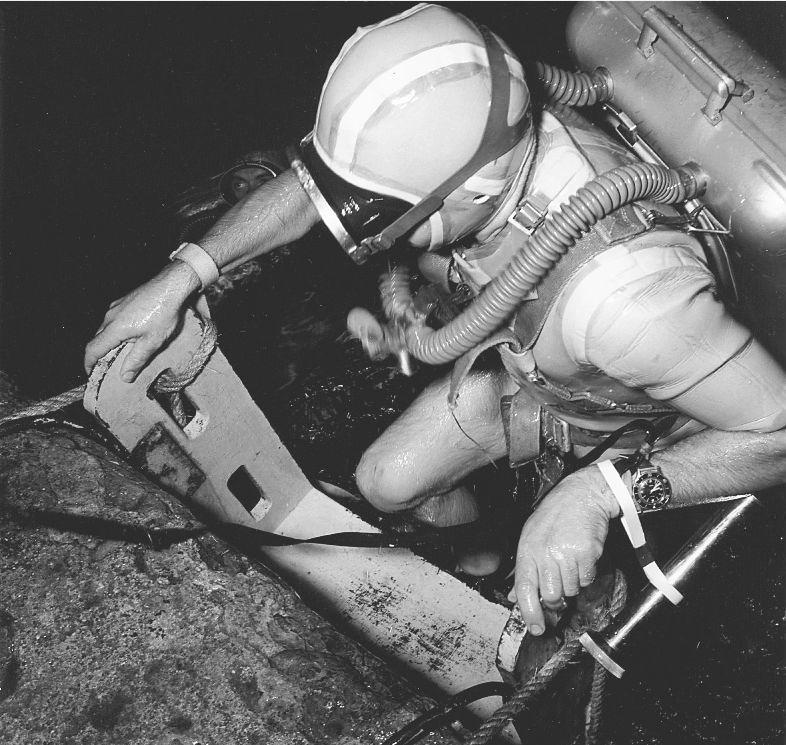
One of the first Blancpain watches 1735 Replica Fifty Fathoms on the wrist of Bob Maloubier, founder of the Nageur de Combat
In many ways, diving watches mean the pinnacle of modern watchmaking. We saw watches being worn on the Moon, exceed the speed of sound, but defeating the immense pressure that prevails only at the deepest points of our planet is a completely different challenge altogether. This is best proven by the process of how watches sneaked out from our vest pockets and onto our wrists, to ultimately become instruments capable of performing in tens or hundreds of thousands special military actions and scientific dives alike, withstanding extremely demanding conditions. It is no wonder then, that dive watch enthusiasts have a special feeling when strapping a watch with such pedigree on: as weird as it may sound for “outsiders,” it does grant a feeling of indestructibility when your only and most important accessory has stood the tests of such demanding conditions. So let’s take a closer look at what led from the first “waterproofs” to the engineering masterpieces that made it to the Mariana trench–and back.
For a kick-off, it is important to clarify that the Rolex Oyster indeed was the first properly waterproof watch–as validated by Gleitze’s swim and the time it spent in fish tanks. However, it was with reason that she wore it on a necklace and not on her wrist: this way the watch had been not subjected to the rather brutal forces of it splashing into the water with every motion of her arm, for hours on end. The first step towards improved durability was the already discussed Omega Marine, but even so, it saw little use as professional diving (not to mention its much later developed, hobby-inspired alternatives) had not been fully developed at the time. In fact, it took the better part of another decade or so until underwater activities became more ubiquitous; the primary reason being that diving equipments were very heavy, not very safe, and limited in availability. This radically changed with the 1942 invention of Jacques-Yves Cousteau and Émile Gagnan: the aqua-lung.
This is important as it greatly affected the future of dive watches, so let’s briefly discuss what this new equipment was. The aqua-lung was the first open circuit breathing apparatus that allowed dives up to depths of 60 meters (or around 180 feet), all without direct connection with the surface. The most important consequence of it was that it helped accelerate developments in the fields of both professional, scientific, and hobby diving, hence making them more widely available around the world. As a result of World War II, warfare and the following popularization of diving, more refined and more durable accessories were required, items such as depth meters, compasses and, of course, wristwatches.
It would make things a lot easier if we could start discussing the history of dive watches with a single model, but things are never so straightforward, unfortunately. Many brands wish to–and can rightfully–claim that they were the first, albeit all in different ways. With that said, once we start digging deeper than mere marketing communication allows, the picture starts to clear up and the truly revolutionary watches and brands become more easily identifiable.
